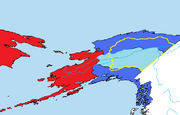North to the Future | |||
| Anthem | ""Alaska's Flag"(unofficial)" | ||
| Capital (and largest city) |
Fairbanks | ||
| Language | English | ||
| Religion | Protestant, Tchiaq Ukpibun | ||
| Demonym | Alaskan, Free Alaskan, Alaska Republican | ||
| Government | Federal presidential constitutional republic | ||
| President | |||
| Established | 1969 | ||
| Currency | Gold Standard | ||
The Free Republic of Alaska is a successor state to the United States founded in 1969 in the Interior of Alaska.
History
Pre-Apocalypse Timeline
As the Zombie horde began to infect the contiguous states in the US, Alaska remained very much untouched at that time. Alaska was left to itself, and the State of Alaska became, by all objective views, an independent entity, though still officially under control of the United States. In reality, the isolated government had very little way to keep in contact with the mainland, after most of the Pacific coast was lost in the sea of Zombies. The USSR had fears that the horde would spread north, and perhaps infest itself in the Soviet far East, so Alaska was invaded, to be used as a checkpoint preventing any infected persons across the Bering Strait. The virus was still a long way from Alaska at this time, and the locals were not apt to let the Russians control sovereign territory of the United States. Locals and US military personnel stationed in the region successfully liberated most of the occupied territory along the northern coast, and recaptured the strategic port of anchorage. The Russians met them with fierce resistance, and did not yield the western coast. Locked in a stalemate, the Alaskans asked the USA for aid, but the US could not spare any men, due to the extent of the Zombie infestation. Furious at the US's inability to protect its state, 57 delegates met in Fairbanks on September 30, 1969, and voted unanimously that the former State of Alaska was now an independent entity, and was to be known henceforth as the Free Republic of Alaska.

The Yellow line represents the original borders of The Free Republic of Alaska in 1969
The Alaskan War of Independence: 1969-1976
See: Alaskan War Of Independence
The Alaskan rebels had very little support in 1969. Over the winter, most of the interior was united. Alaskan guerrillas were well suited to the cold arctic winters and conducted extensive operations. Not all operations were military, but some were feats of engineering. The Alaskan Army Engineering Corps was founded in January of 1970, to put the small backwoods nation together into a country capable of projecting power into other areas of the former state. Mines had to be repossessed, and reopened, factories were re-started, bridges were built, railroads were fixed, and electrical wires were re-laid. Most importantly, in March, construction was started on defenses that would secure the frontiers of the nation. Temporary defenses had been build before, but the kind of work needed to build more efficient defenses had to take place after the snow began to thaw. Unfortunately for the rebels, the warmer weather also enabled the Alaskan State Army to begin more operations. Much of the northern territory was lost before sufficient defenses could be put in place. The battles in the north did give engineers enough time to construct fortifications much farther south than anticipated. The rebels, to halt the advance effectively, began "Operation Wedge," a military campaign to isolate US troops in the north from the important city of Anchorage. The operation was a success, and the line was once again drawn into a stalemate, as the US troops in the north lost their vital supply line. Both sides began to regroup, until the battle of Denali in August. US troops began the "McKinley Campaign," an operation whose aim was to take Fairbanks by launching an operation over the Alaskan Range. The Range was not fortified as extensively, mainly because the construction there would be difficult and hazardous, but also because an attack over the Range was not expected. needless to say, it was the most desirable choice for an invasion into rebel territory, and the attack commenced on August 2, 1970. The attack was initially successful, but the Rebels showed strong resistance around Healy. A decisive victory occurred on August 17th, when reinforcements from the North attacked the flank of the invaders, and drove them back across the range. The battle flag of the Denali Regiment which successfully defended Healy became very popular as a national flag, and after the war, became the official flag of the nation. Two months later, on November 13th, the Valdez Offensive, also known officially as "Operation Seaboard," was launched. The operation looked easy enough on paper. The Free Alaskans would attack over the weakest point of the Alaskan Range to capture the ports of Valdez and Cordova. Once a shipping lane could be established between the Free Alaskans and the survivor states of the Pacific Northwest, the Free Alaskan army could be transformed from a rag-tag militia into a superior fighting force. The operation went smoothly enough at first, but on December 1st, US reinforcements from Anchorage managed to gain a foothold within the City of Valdez. With a lack of Artillery, the Free Alaskans had no choice but fierce house-to-house Stalingrad-esque fighting. The battle would continue for over a year, until artillery guns purchased form the Bay Republic became available to shell the city. The US troops in Valdez surrendered on Christmas Eve, December 24th, 1971. While the Siege of Valdez was still ongoing, the Free Alaskans found an opportunity to free the Soviet-occupied lands to the East, whose freedom had been their original Cause of Secession. on the 11th of July, 1971, the USSR was hit by a terrorist bombing in Moscow, which lead the unrest already evident in the country to turn to violence. the Free Alaskans, taking advantage of the political situation, sent a three-pronged assault into the country during their Western Offensive. The political unity in the east proved much more effective; predominately Russian areas lacked the ethnic disunity seen in the USSR. Despite this, the Free Alaskans pushed forward, and on October 27th, 1971, Bethel was taken, and Premier Felix Volkov surrendered the territories of Eastern Alaska to the Free Alaskans. The Russian Garrison was paroled, a practice that had become common as a way to deal with prisoners of war. All citizens, including those under military service, would have until the end of the year to pledge Allegiance to the nation of Free Alaska or leave the country. Miroslav Zhdanov, the Soviet General tasked with defending Bethel was also paroled, but he and some of his followers broke parole and escaped to the north. They created the Army for Russian Liberation, a terrorist group that wished to restore Alaska to Russian rule. The ARL was one of the first dissenting groups of conquered peoples that came to be in Alaska during the war. most fled to the open spaces in the north, where they could build up small armies without the government's eye on them.
Military
Army
The Free Alaskan Army is the largest military unit in the Free Alaskan Republic. Uniforms are not standardized throughout the army, but they are standardized by Regiment. Their equipment is standardized as every soldier being required to have the following:
- One summer uniform.
- One winter uniform.
- One rifled/shouldered firearm, and a sidearm OR one shotgun, and a sidearm.
- One canteen.
- One haversack.
- Rations to survive three days in the field.
- Two Grenades.
- Three Clips of ammunition for automatic weapons, 100 rounds for a sidearm, 75 rounds per rifle, 40 shotgun shells.
Other units have different requirements. The Special Forces Regiment operates in mainly guerrilla operations, and often uses skis, demolitions equipment, and may dress as civilians. The Engineering Corps uses a variety of equipment, but is also involved in combat roles. Vehicles are sometimes used, but most units do not have them. Oil is plentiful, but with few ways to refine it, gasoline is not easily found.
Regiments:
The Alaskan military is divided into regiments. The regiments are as follows:
- Yukon Regiment:
- Headquarters: Fort Yukon
- Leader: General David Kindrick
- Serves around the Canadian Border
- Central Regiment
- Headquarters: Fairbanks
- Leader: General Vernon Ball
- Serves around much of the interior centered around Fairbanks
- Western Regiment
- Headquarters: McGrath
- Leader: General Todd Hardwick
- Serves around the western frontier
- Brooks Regiment
- Headquarters: Beaver
- Leader: General Daniel Efimov
- Serves around the northern frontier, south of the Brooks Range
- Denali Regiment
- Headquarters: Healy
- Leader: General William Cote
- Serves along the south frontier, along the Alaskan Range.
Awards
The Alaskan government has created certain awards to Honor those men and their unit for distinguished heroism.
Presidential Unit Citation- This award is awarded to units that act independently, cohesively, and in some cases, succeed in the face of certain defeat.
- Denali Regiment- For actions during the defense of Healy.
Pole Star Medal- This award is given to individuals who show distinguished leadership on the battlefield
- General William Cote- For actions leading to victory in the Battle of Denali.
Government
The government consists of executive, judicial and legislative branches. It is a federal system, whereby the legislature, known as The Delegation, comprised of representatives from all the Borough of Alaska, meet to decide national law. All boroughs are represented, even if under occupation. Boroughs are encouraged to do most of the governing themselves, and the legislature very rarely passes a new law. The executive branch is headed by a president with powers similar to the president of the United States. The President serves a six-year term, and may serve a total of two terms. The judicial branch is comprised of judges. The president is required to pick a certain amount of judges from each borough. The Delegation votes on the judges that the President has picked to decide whether they will become judges of the Supreme Court. The Supreme Court judge's term lasts for ten years.
Presidents of The Free Republic of Alaska
- 1969: Wally Hickel (Provisional)
- 1970-1976: Wally Hickel (Elected,First Term)
- 1976-present: Wally Hickel (Second Term)
Foreign Relations
Allies:
- Bay Republic
- Halifax
Good Condition:
- Northwest Federation
- Cascadia
- Canada
Not Trusted/Hated:
- United States
- USSR
At War with:
- The State of Alaska
Trade
Used Domestically
- Metal
- Water
- Brick
- Concrete
- Lumber
- Coal
Imported
- Guns
- Ammunition
- Wheat
Exported
- Bears (Grizzly)
- Unrefined Ores
Development
Army
- Soldiers: 25,000 Active, 15,000 reserve [Lvl 2]
- Resources [Lvl 3]
- Money rating [???]
- Current rating: 2
- Ships: Seven [Lvl 1]
- Resources [Lvl 3]
- Money rating [???]
- Current rating: 1
Industry
- Population: 55,000 [Lvl 2]
- Resources [Lvl 5]
- Money Rating [???]
- Current Rating: 1
| ||||||||||||||

